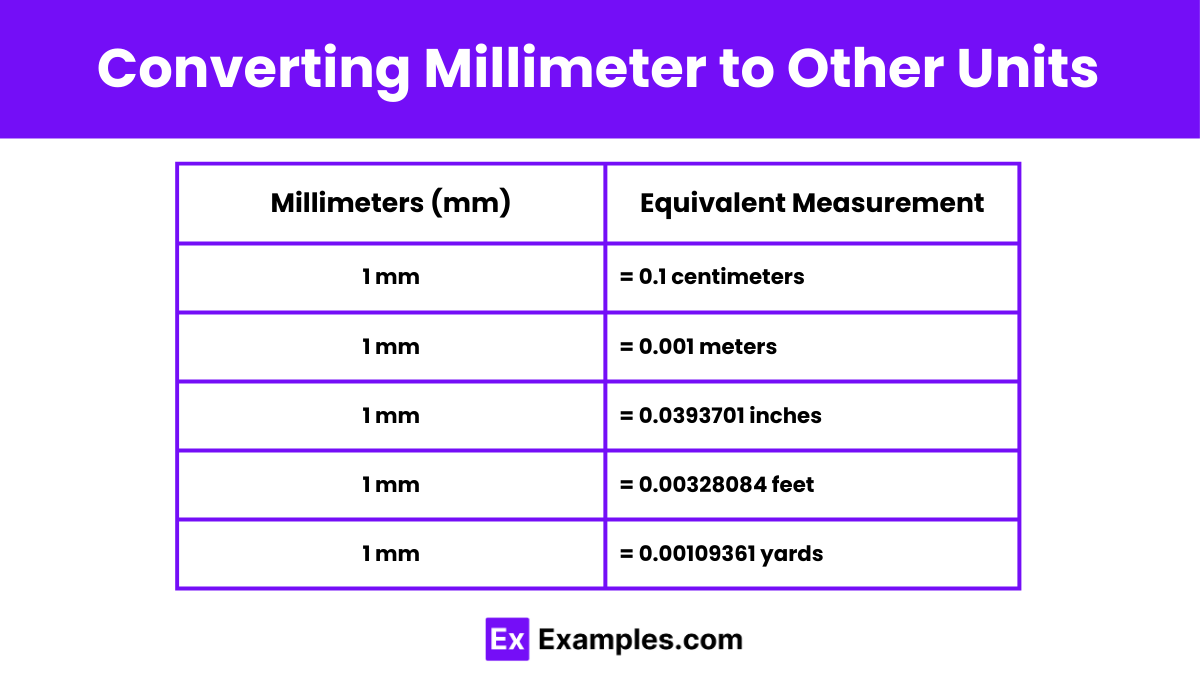How many millimeters are there in one centimeter?
10
100
1
1000

A millimeter, one-thousandth of a meter, is essential for precision in engineering, manufacturing, and scientific research. This tiny measurement unit is perfect for gauging small objects like wires and card thickness. Mastering millimeter usage and conversions is key to accuracy in both daily activities and specialized tasks.
A millimeter is a unit of length in the metric system, equivalent to one thousandth of a meter. It is widely used for precise measurements in various fields such as engineering, construction, and science. The small scale of the millimeter makes it ideal for tasks requiring high accuracy, like designing mechanical components, measuring thicknesses, and creating detailed architectural plans. In everyday use, millimeters help accurately size small objects like jewelry or electronic parts. The millimeter is crucial for achieving the precision necessary in many technological and scientific applications.

Measuring millimeters with precision requires specific tools that can provide accurate and fine readings. Here are eight tools commonly used for measuring in millimeters:
Each of these tools is suitable for different scenarios, from DIY projects to high-precision engineering tasks, ensuring accurate measurement in millimeters.

Here is a table showing how to convert millimeters to other common units of length:
| Millimeters (mm) | Equivalent Measurement |
|---|---|
| 1 mm | 0.1 centimeters |
| 1 mm | 0.001 meters |
| 1 mm | 0.0393701 inches |
| 1 mm | 0.00328084 feet |
| 1 mm | 0.00109361 yards |
| 10 mm | 1 centimeter |
| 1000 mm | 1 meter |
This table provides the conversion factors needed to translate measurements from millimeters into various other units used in everyday life and specialized fields.
Here are the conversions for millimeters to various other units of measurement, formatted similarly to your request:
Multiply the millimeter value by 0.1 to get centimeter, since 1 mm equals 0.1 centimeters.
Example: 10 mm is 10 x 0.1 = 1 cm.
Multiply the millimeter value by 0.001 to convert to meters.
Example: 1000 mm is 1000 x 0.001 = 1 m.
Multiply the millimeter value by 0.0393701 to convert to inches.
Example: 25 mm is 25 x 0.0393701 = 0.9842525 inches.
Multiply the millimeter value by 0.00328084 to convert to feet.
Example: 1000 mm is 1000 x 0.00328084 = 3.28084 feet.
Multiply the millimeter value by 0.00109361 to get yards.
Example: 1000 mm is 1000 x 0.00109361 = 1.09361 yards.
Divide the millimeter value by 1,000,000 to convert to kilometers.
Example: 1,000,000 mm is 1,000,000 ÷ 1,000,000 = 1 km.
Multiply the kilometer value by 1,000,000 to convert to millimeters.
Example: 2 km is 2 x 1,000,000 = 2,000,000 mm.
These conversions provide a clear method to translate measurements from millimeters into a variety of other units, using simple multiplication and division.

Millimeters are widely used for their precision in measuring very small distances. Here are some of the primary uses of millimeters:
These uses highlight the importance of millimeters as a unit of measurement across various industries where accuracy and detail are paramount.
1 millimeter is 1/1000th of a meter. It’s a very small unit, typically used to measure dimensions that require high precision.
An item that is 1mm long is about the size of the tip of a sharp pencil or slightly thicker than a standard credit card’s thickness.
1/4 inch is approximately 6.35 millimeters.
Yes, 1 inch is significantly larger than 1 mm. One inch equals 25.4 millimeters.
5 mm is roughly the diameter of a standard pencil eraser or the thickness of three stacked U.S. dimes.
Text prompt
Add Tone
10 Examples of Public speaking
20 Examples of Gas lighting
How many millimeters are there in one centimeter?
10
100
1
1000
How many millimeters are in 3 centimeters?
3
30
300
3000
If a length is 45 millimeters, how many centimeters is this?
45
450
4.5
0.45
How many millimeters are there in 1 meter?
1000
10,000
100
100,000
What is the conversion of 250 millimeters into centimeters?
2.5
25
2500
0.25
How many millimeters are there in 5.6 centimeters?
56
5.6
560
56,000
If a ruler measures 120 millimeters, how many centimeters is this?
1.2
120
12
0.12
A piece of paper is 297 millimeters long. How many centimeters is this?
29.7
297
2.97
2970
What is the length in millimeters if an object is 0.75 meters long?
75
750
7500
7.5
How many millimeters are there in 8.2 centimeters?
82
8.2
820
0.82
Before you leave, take our quick quiz to enhance your learning!

